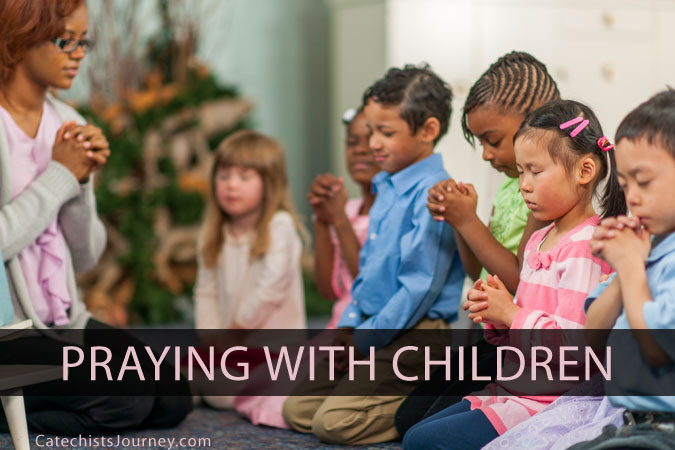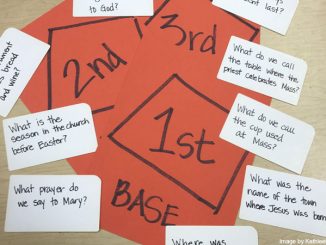Long-time catechists may find themselves going back to the tried-and-true activities that they’ve used before with predictable outcomes. But sometimes breaking out of that cycle can be a good thing.
For a number of years, I would print out artwork that depicted the Nativity. I had 15–20 images from various artists. The first-grade children and I would sit in a circle on the floor, and I would show the images to the class and then pass them around. It worked well enough.
As museums started putting their collections online and permitted educators to download images, I decided to try something new. Admittedly, I was nervous. I’m not an art historian, and I had never used this sort of technology in my lesson before. But I reminded myself that I wasn’t an art historian when I passed around print-outs either, and it worked just fine.
I searched for “nativity” on the National Gallery of Art’s website. I downloaded many images depicting the Annunciation, Joseph’s dream, the Visitation, the birth of Jesus, and the visit from the Magi. I selected 30 images and created a PowerPoint presentation. We talked about each image as I presented them on a screen for all to see.
The children were shocked to realize that Jesus would have been “in diapers” or would have actually slept among animals. We talked about why one artist might have imagined a scene one way and another artist had a different idea. The children noticed that in some paintings there was a glow about Jesus. They were picking up on details that I did not expect. They answered each other’s questions with thoughtful responses, which also surprised me. Truth be told, I did a lot less teaching that day than I expected to.
We were looking at The Adoration of the Magi by Jan Gossaert (image above). I was encouraging the class to experience that scene as if they were standing there looking at and hearing what was happening. There is a lot going on in the painting to see. There are angels overhead, dogs in the foreground, the Magi with gifts, Jesus holding a chalice, and a crowd of onlookers. I was focused on the Magi coming to this lowly stable and meeting Jesus on bended knee. I was feeling pretty confident about the way I was presenting this painting.
Then one of my first-graders piped up, “I think that boy in the back wants to come forward and see, but he’s too afraid because he’s poor.”
I didn’t even know who he was talking about; the student had to come up and point him out on the screen. I was so focused on the main players that I didn’t even notice this person relegated to the background. And yet, my student saw him right away. (That, in itself, was a pretty major takeaway for me.)
My student told the class that he thought the person in the background wouldn’t come forward because he didn’t have a gift to offer (hence, the idea that he was poor) and therefore felt less welcome. Our conversation took an entirely different turn. We shifted from the Magi to the people in the background. We talked about who the boy might be and how he ended up there that day. We talked about whether Jesus would have wanted only rich people to come and visit him. We wondered whether the boy in the background of the painting could understand that Jesus welcomes him too. We discussed what that meant to us in our daily life. What gifts do we have that we can share? Do we welcome those who have less?
What started out as a plan to teach about the birth of Christ became something much more powerful and personal for both me and my class. The lesson never would have happened the way it did—if at all—were it not for the PowerPoint presentation. Because we shared the art together, we were able to have a conversation in which everyone was able to share their thoughts and observations.
Trying something new can be scary, but the Holy Spirit will take us to some wonderful places when we do. When have you tried something new in your classroom? What surprised you?
With 25 different prints per easel, per grade, the Finding God Art Prints provide background about the artist, medium, and history and also offer activities related to the art, including art projects, music, movement, and using imagination in prayer. Oversized for easy viewing and impact, the fine art prints get kids out of their seats and enjoying class in ever more meaningful ways.

![The Adoration of the Magi by Jan Gossaert [Public domain], via Wikimedia Commons](https://catechistsjourney.loyolapress.com/wp-content/uploads/2017/12/Adoration-of-the-Magi-by-Jan-Gossaert.jpg)




This was beautiful and I must say clever. I too am trying something new this year. The Children will do the decorations of the Christmas Tree and decorate as well so that they can express how they feel about the Birth of Jesus! I agree to go outside the box to grow in Faith together. GOD BLESS YOU AND YOURS! Thank you!
Merry Christmas and a Blessed 2018!
I love these ideas and bringing Christ through beautiful paintings which they will remember and be interested in. The parents ,I think , will enjoy this activity ad much or more than the children. Can’t tell you how excited I am to start this,
The little boy in the background reminds me of the Little Drummer Boy who played his drums 🥁 and played his best for the Child Jesus as his gift to him.
Thank you for another wonderful idea, I have tried bring artwork to my first grade classes but never thought of using it in this exciting way.